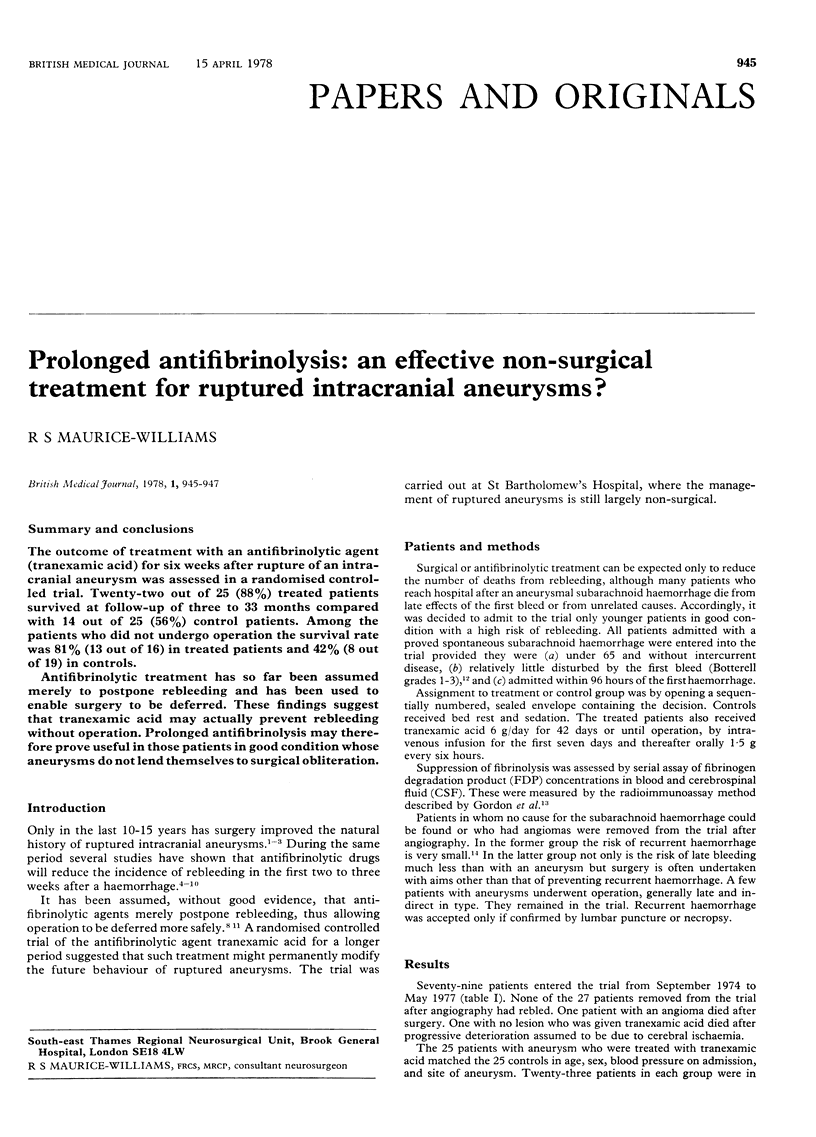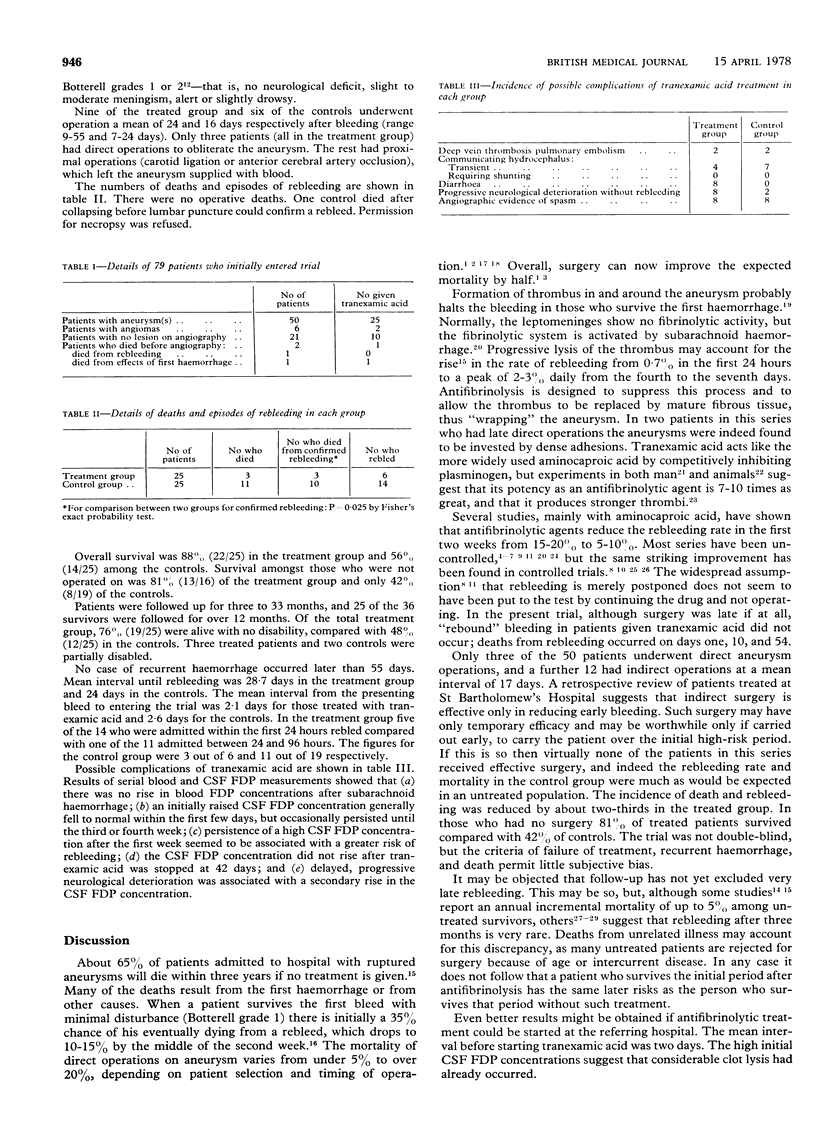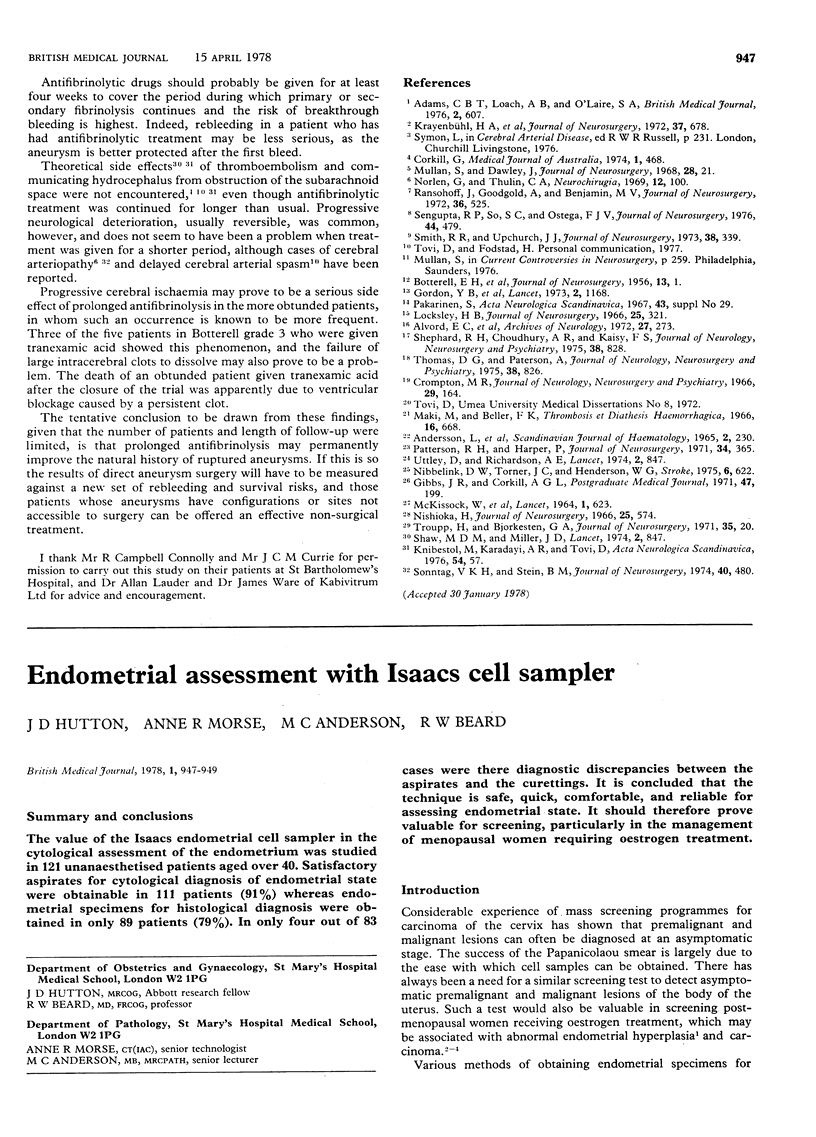Abstract
The outcome of treatment with an antifibrinolytic agent (tranexamic acid) for six weeks after rupture of an intracranial aneurysm was assessed in a randomised controlled trial. Twenty-two out of 25 (88%) treated patients survived at follow-up of three to 33 months compared with 14 out of 25 (56%) control patients. Among the patients who did not undergo operation the survival rate was 81% (13 out of 16) in treated patients and 42% (8 out of 19) in controls. Antifibrinolytic treatment has so far been assumed merely to postpone rebleeding and has been used to enable surgery to be deferred. These findings suggest that tranexamic acid may actually prevent rebleeding without operation. Prolonged antifibrinolysis may therefore prove useful in those patients in good condition whose aneurysms do not lend themselves to surgical obliteration.
Full text
PDF


Selected References
These references are in PubMed. This may not be the complete list of references from this article.
- Adams C. B., Loach A. B., O'laoire S. A. Intracranial aneurysms: analysis of results of microneurosurgery. Br Med J. 1976 Sep 11;2(6036):607–609. doi: 10.1136/bmj.2.6036.607. [DOI] [PMC free article] [PubMed] [Google Scholar]
- Corkill G. Earlier operation and antifibrinolytic therapy in the management of aneurysmal subarachnoid haemorrhage. Review of recent experience in Tasmania. Med J Aust. 1974 Mar 30;1(13):468–470. doi: 10.5694/j.1326-5377.1974.tb50844.x. [DOI] [PubMed] [Google Scholar]
- Gordon Y. B., Martin M. J., McNeile A. T., Chard T. Specific and sensitive determination of fibrinogen-degradation products by radioimmunoassay. Lancet. 1973 Nov 24;2(7839):1168–1170. doi: 10.1016/s0140-6736(73)92937-1. [DOI] [PubMed] [Google Scholar]
- Knibestöl M., Karadayi A., Tovi D. Echo-encephalographic study of ventricular dilatation after subarachnoid hemorrhage, with special reference to the effect of antifibrinolytic treatment. Acta Neurol Scand. 1976 Jul;54(1):57–70. doi: 10.1111/j.1600-0404.1976.tb07620.x. [DOI] [PubMed] [Google Scholar]
- Locksley H. B. Natural history of subarachnoid hemorrhage, intracranial aneurysms and arteriovenous malformations. J Neurosurg. 1966 Sep;25(3):321–368. doi: 10.3171/jns.1966.25.3.0321. [DOI] [PubMed] [Google Scholar]
- MCKISSOCK W., RICHARDSON A., WALSH L., OWEN E. MULTIPLE INTRACRANIAL ANEURYSMS. Lancet. 1964 Mar 21;1(7334):623–626. doi: 10.1016/s0140-6736(64)91449-7. [DOI] [PubMed] [Google Scholar]
- Maki M., Beller F. K. Comparative studies of fibrinolytic inhibitors in vitro. Thromb Diath Haemorrh. 1966 Dec 1;16(3):668–686. [PubMed] [Google Scholar]
- Mullan S., Dawley J. Antifibrinolytic therapy for intracranial aneurysms. J Neurosurg. 1968 Jan;28(1):21–23. doi: 10.3171/jns.1968.28.1.0021. [DOI] [PubMed] [Google Scholar]
- Nibbelink D. W., Torner J. C., Henderson W. G. Intracranial aneurysms and subarachnoid hemorrhage. A cooperative study. Antifibrinolytic therapy in recent onset subarachnoid hemorrhage. Stroke. 1975 Nov-Dec;6(6):622–629. doi: 10.1161/01.str.6.6.622. [DOI] [PubMed] [Google Scholar]
- Norlén G., Thulin C. A. The use of antifibrinolytic substances in ruptured intracranial aneurysms. Neurochirurgia (Stuttg) 1969 May;12(3):100–102. doi: 10.1055/s-0028-1095290. [DOI] [PubMed] [Google Scholar]
- Patterson R. H., Jr, Harpel P. The effect of epsilon aminocaproic acid and tranexamic acid on thrombus size and strength in a simulated arterial aneurysm. J Neurosurg. 1971 Mar;34(3):365–371. doi: 10.3171/jns.1971.34.3.0365. [DOI] [PubMed] [Google Scholar]
- Ransohoff J., Goodgold A., Benjamin M. V. Preoperative management of patients with ruptured intracranial aneurysms. J Neurosurg. 1972 May;36(5):525–530. doi: 10.3171/jns.1972.36.5.0525. [DOI] [PubMed] [Google Scholar]
- Sengupta R. P., So S. C., Villarejo-Ortega F. J. Use of epsilon aminocaproic acid (EACA) in the preoperative management of ruptured intracranial aneurysms. J Neurosurg. 1976 Apr;44(4):479–484. doi: 10.3171/jns.1976.44.4.0479. [DOI] [PubMed] [Google Scholar]
- Shaw M. D., Miller J. D. Letter: Epsilon-aminocaproic acid and subarachnoid haemorrhage.?211. Lancet. 1974 Oct 5;2(7884):847–848. doi: 10.1016/s0140-6736(74)91120-9. [DOI] [PubMed] [Google Scholar]
- Shephard R. H., Choudhury A. R., Kaisy F. S. Proceedings: Anterior communicating artery aneurysms. J Neurol Neurosurg Psychiatry. 1975 Aug;38(8):828–828. doi: 10.1136/jnnp.38.8.828-a. [DOI] [PMC free article] [PubMed] [Google Scholar]
- Smith R. R., Upchurch J. J. Monitoring antifibrinolytic therapy in subarachnoid hemorrhage. J Neurosurg. 1973 Mar;38(3):339–344. doi: 10.3171/jns.1973.38.3.0339. [DOI] [PubMed] [Google Scholar]
- Thomas D. G., Paterson A. Results of surgical treatment of pericallosal aneurysms. J Neurol Neurosurg Psychiatry. 1975 Aug;38(8):826–826. doi: 10.1136/jnnp.38.8.826-b. [DOI] [PMC free article] [PubMed] [Google Scholar]
- Troupp H., af Björkesten G. Results of a controlled trial of late surgical versus conservative treatment of intracranial arterial aneurysms. J Neurosurg. 1971 Jul;35(1):20–24. doi: 10.3171/jns.1971.35.1.0020. [DOI] [PubMed] [Google Scholar]


